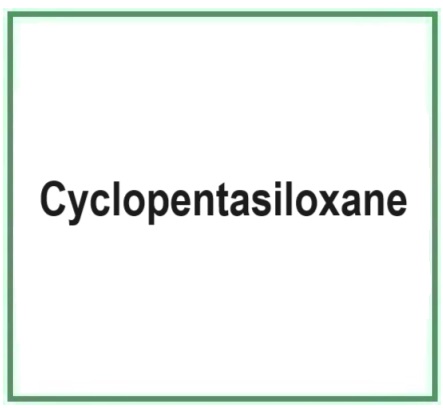Cyclopentasiloxane is a chemical compound containing cyclomethicone, cyclic dimethylpolysiloxane, noncrystallisable synthetic volatile silicone and is the industry name for D5.
The name describes the structure of the molecule:
- Cyclopenta refers to the compound's cyclic structure, which includes a five-membered ring.
- Siloxane indicates the presence of silicon and oxygen units in the molecule. Siloxanes are a class of silicon compounds known for their emollient properties and the ability to form light, non-greasy films.
Raw Materials and Their Functions
Silicon and Oxygen. Key elements in the formation of silicone compounds like cyclopentasiloxane. Silicon provides the basic structure, while oxygen forms bonds with silicon to create the cyclic structure of the compound.
Industrial Chemical Synthesis of Cyclopentasiloxane
- Polymerization of silicon-based compounds to form a cyclic structure. This can involve the reaction of chlorosilanes with water or other reagents to form cyclopentasiloxane.
- Reaction Control. The polymerization reaction is monitored to ensure it occurs correctly and the final product has the desired properties.
- Purification. After polymerization, cyclopentasiloxane is purified to remove impurities and by-products.
- Quality Control. The purified cyclopentasiloxane undergoes quality checks to ensure it meets the required standards.
Form and color
Cyclopentasiloxane occurs as a colorless viscous liquid.

What it is used for and where
Cosmetics
Banned in cosmetics if it contains D4 silicone.
Cyclopentasiloxane is used in cosmetic products such as creams, lotions, and hair products for its conditioning properties and its ability to evaporate quickly, leaving the skin feeling smooth without a greasy sensation. It is valued for its ability to improve the spreadability of the product on the skin and to provide a silky feel.
Hair conditioning agent. A large number of ingredients with specific purposes can co-exist in a hair shampoo: cleansers, conditioners, thickeners, mattifying agents, sequestering agents, fragrances, preservatives, special additives. However, the indispensable ingredients are the cleansers and conditioners as they are necessary and sufficient for hair cleansing and manageability. The others act as commercial and non-essential auxiliaries such as: appearance, fragrance, colouring, etc. Hair conditioning agents have the task of increasing shine, manageability and volume, and reducing static electricity, especially after treatments such as colouring, ironing, waving, drying and brushing. They are, in practice, dispersing agents that may contain cationic surfactants, thickeners, emollients, polymers. The typology of hair conditioners includes: intensive conditioners, instant conditioners, thickening conditioners, drying conditioners.
Skin conditioning agent. An ingredient that is the mainstay of topical skin treatment by restoring, increasing or improving skin tolerance to external factors, including melanocyte tolerance. The most important function of the conditioning agent is to prevent skin dehydration, but the subject is rather complex and involves emollients and humectants.
Skin conditioning agent - Emollient. Emollients have the characteristic of enhancing the skin barrier through a source of exogenous lipids that adhere to the skin, improving barrier properties by filling gaps in intercorneocyte clusters to improve hydration while protecting against inflammation. In practice, they have the ability to create a barrier that prevents transepidermal water loss. Emollients are described as degreasing or refreshing additives that improve the lipid content of the upper layers of the skin by preventing degreasing and drying of the skin. The problem with emollients is that many have a strong lipophilic character and are identified as occlusive ingredients; they are oily and fatty materials that remain on the skin surface and reduce transepidermal water loss. In cosmetics, emollients and moisturisers are often considered synonymous with humectants and occlusives.
Solvent. It is the substance for dissolving or dispersing surfactants, oils, dyes, flavourings, bactericidal preservatives in solution.
CAS 541-02-6
UNII 0THT5PCI0R
Molecular Weight 370.77 g/mol
EC number 208-764-9
DTXSID1027184
Safety
Silicones possess high chemical stability, but low biodegradability and high bioaccumulation potential.
It is an ingredient that has high bioaccumulation and persistence as well as non-reproductive organ toxicity properties (1), may contain trace amounts of Cyclotetrasiloxane (D4), which is classified in the EU as toxic to reproduction and is considered locally toxic if inhaled, so restrictions have been proposed for D4 and D5 in personal care products under the Reach regulation due to environmental concerns . However, a recent 2017 study concludes"The ECHA Committee for Risk Assessment concluded that D4 and D5 should not be placed in the EU market in cosmetic products and personal care products in concentrations ≥0.1% by weight of each of the substances (RAC, 2016). In 2017, the EU Scientific Committee for Consumer Safety updated their assessment of consumers risk (SCCS, 2015), concluding that the use of D5 in cosmetic products is safe at the reported concentrations, except when it is used in hair styling aerosols and sun care spray products, which contain high concentrations of aerosolized D5 (SCCS, 2017). Moreover, the concentration of D4 as an impurity of D5 should be kept as low as possible."
References________________________________________________________________________
(1) Goussard, V., Aubry, J. M., & Nardello-Rataj, V. (2022). Bio-based alternatives to volatile silicones: Relationships between chemical structure, physicochemical properties and functional performances. Advances in Colloid and Interface Science, 102679.) Vietato in cosmetica se contiene silicone D4.
(2) Scientific Committee on Consumer Safety (SCCS). Electronic address: sante-c2-SCCS@ec.europa.eu; Rousselle DC. Opinion of the Scientific Committee on Consumer Safety (SCCS) - Final version of the opinion on decamethylcyclopentasiloxane (cyclopentasiloxane, D5) in cosmetic products. Regul Toxicol Pharmacol. 2017 Feb;83:117-118. doi: 10.1016/j.yrtph.2016.11.016. Epub 2016 Nov 12. PMID: 27845160.
![]() Cyclopentasiloxane
Cyclopentasiloxane 



